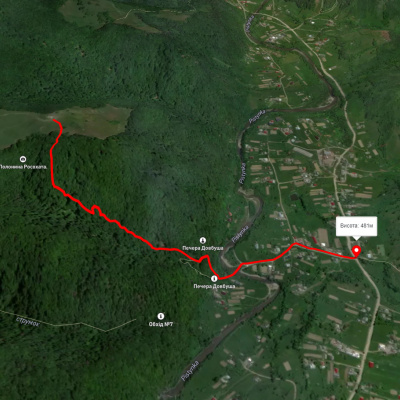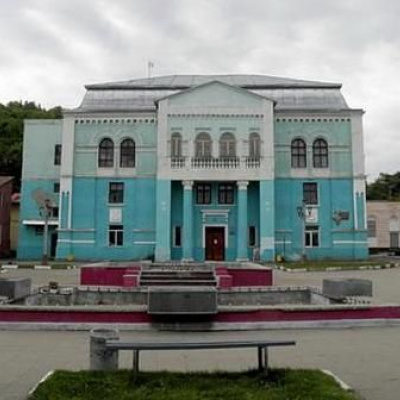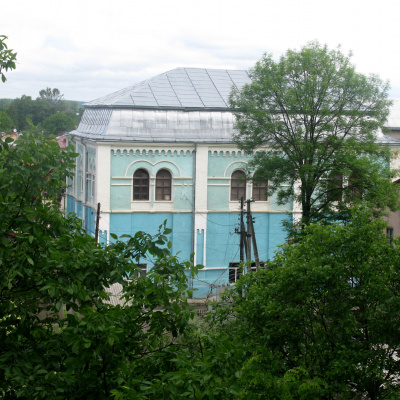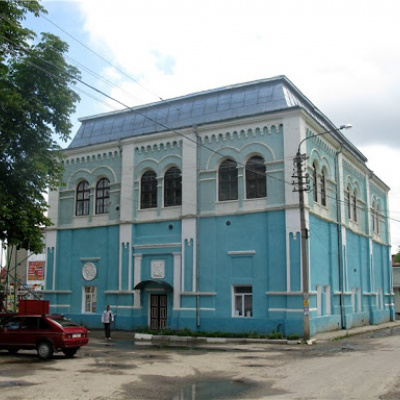The main synagogue, Vyzhnytsia
Thetown of Vyzhnytsia used to be considered one of the Jewish centers of Bukovyna. At the beginning of the 20th century, the share of Jews was up to 90% of the city's population. At that time there were 11 synagogues. The main synagogue is the largest of them, which has survived to this day.
Themain synagogue (now the City People's House of Creativity and Leisure) in Vyzhnytsia, Chernivtsi Oblast, was built in 1789 and is located in the city center, on the main square. It is known that the Jewish community settled in this town in the seventeenth century. Mostly respected merchants prayed in the main synagogue, and later synagogues for young people, timber traders, and ordinary people were built in Vyzhnytsia. In its architectural design, the main synagogue is a three-tiered turquoise-colored building with a pitched roof, characterized by its attractive aesthetic appearance.
The synagogue was built in the middle of the 19th century. The First World War severely damaged the building - it burned and stood devastated throughout the interwar period, until the building was reconstructed by the Soviet authorities in the 1960s, turning it into a House of Culture, which it still is today. By the way, at the beginning of Ukraine's independence, only 3 Jewish families lived in the city. These were all that remained of the city's once large and prosperous Jewish community.
The building is an interesting example of Jewish sacred architecture in Bukovyna. The main synagogue is the dominant building on the central square of Vyzhnytsia. Behind the main synagogue is a small synagogue for young people. It is now a boiler room. To the left of the former synagogue is a pink two-story building with an original pediment on the central façade and a pitched roof. This is another religious Jewish building, a mikvah that served as a bathhouse for the Jews.
During the First World War, it was burned by Russian troops, after which the building stood in ruins for several decades. It was only in the 1960s that the synagogue was reconstructed and turned into a house of culture, where People's Artist of Ukraine Nazariy Yaremchuk began his career as a member of the Smerichka vocal and instrumental ensemble. Today, it is one of the few well-preserved Jewish shrines, and it is now a community center for creativity and leisure.
The main synagogue in Vyzhnytsia is now a cultural institution, considered one of the dominants in the architecture of the Market Square, and is a local architectural monument. In total, there were approximately eight synagogues in the city; today, in addition to the two mentioned above, a Hasidic synagogue in the western part of the city, near St . Nicholas Church and the Museum of Local Lore, has been preserved in a dilapidated state, and another former synagogue is used as a gym.
The main synagogue is located in the very center of the town on Rynok Square. The most convenient way to get to Vyzhnytsia is by bus from Chernivtsi, Kolomyia, and Ivano-Frankivsk.
Opening hours: We recommend visiting during business hours on weekdays.
Vyzhnytsia is a small Carpathian town with a population of only about 5 thousand people. However, the amazing beauty of the surrounding mountains and forests, the steep Cheremosh, combined with the original architecture of Austrian times makes it a real gem of the Carpathian part of Bukovyna. Vyzhnytsia is located at the foot of the Carpathians, on the right bank of the stormy Cheremosh, 70 km from the regional center of Chernivtsi. The name of the town comes from the word "vyzhniy" (upper).
The first mention of the city is in the Moldovan chronicle of 1501. In 1514-1574 the city was under the rule of the Turks. Until 1774, Vyzhnytsia was subordinated to the Principality of Moldova, and later to Austria-Hungary. At the end of the eighteenth century, with the beginning of the development of the timber industry, Vyzhnytsia became an important point of trade in wood. After the Cheremosh riverbed was regulated (1790-1812), construction timber and firewood were floated to Chernivtsi, and from there, along a dirt road through the Boyany, to Bessarabia and Podillia.
Vyzhnytsia suffered terrible devastation during the First World War. The town changed hands several times, leaving most of the buildings in ruins and the number of inhabitants down to 500.
In 905, a regional school of carving, turning, and metal ornamentation was organized in Vyzhnytsia. It was attended by 20 children. Its founders and teachers were the famous Hutsul carvers Vasyl Shkribliak, Vasyl Devdiuk, Marko Megedeniuk, and Fedir Hnatiuk. The school's products soon became known far beyond the region.
During 1869-1872, the writer Yurii Fedkovych worked as an inspector of schools in the Vyzhnytsia district. Ukrainian artist, writer, and public figure Kornylo Ustianovych (1839-1903) lived and died in Vyzhnytsia for some time. The famous Polish artist Juliusz Kosak (1824-1899) was born here; the Polish artist Anna Czartoryska spent her childhood and adolescence here.
Ukrainian writers have visited the city: Ivan Franko, Lesya Ukrainka, Vasyl Stefanyk, artist Ivan Trush, and other cultural figures. The city's community always welcomed their favorite artists with hospitality and joy. On 23 July 1901, in honor of Lesia Ukrainka's arrival, a large concert was organized in the largest venue of the time.
Vyzhnytsia is the birthplace of People's Artist of Ukraine Nazar Yaremchuk, the Smerichka vocal and instrumental ensemble and the Smerechyna folk dance ensemble were born here, and Vasyl Zinkevych and many other famous artists began their careers here.
Accommodation around The main synagogue, Vyzhnytsia:
Які маршрути проходять повз The main synagogue, Vyzhnytsia?
Пропонуємо пройти такі туристичні (пішохідні) маршрути через/біля The main synagogue, Vyzhnytsia: пер. Німчич - Протяте Каміння, Смугарські водоспади, с. Буковець – Писаний Камінь – с. Буковець, Писаний Камінь – с. Буковець, Шешори - Росохата, с. Космач, через г. Ротило, г. Грегіт, г. Біла Кобила до с.Буковець
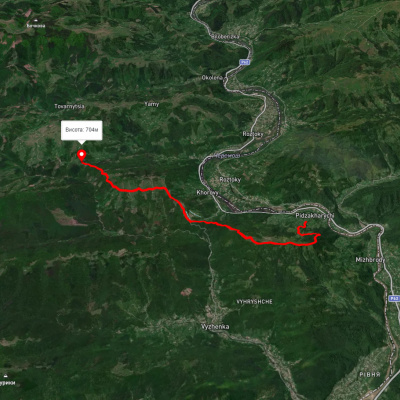
пер. Німчич - Протяте Каміння
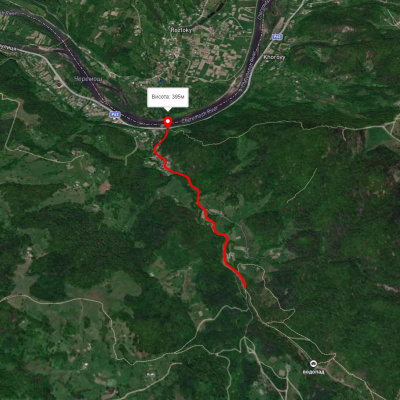
Смугарські водоспади
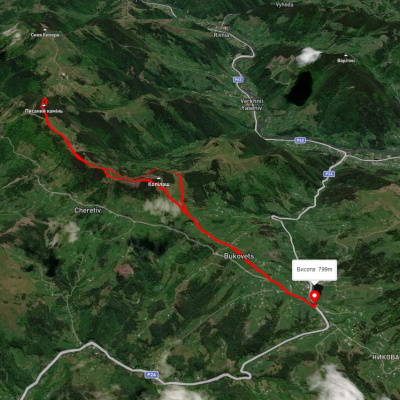
с. Буковець – Писаний Камінь – с. Буковець
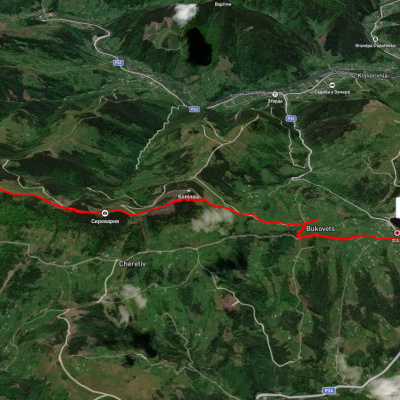
Писаний Камінь – с. Буковець
